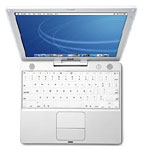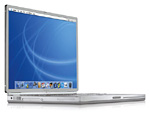There's no question about it - the new iBooks and PowerBooks
represent a better value than their predecessors. In every case Apple
has increased speed while decreasing price. And this should have a
devastating effect on the value of used and just discontinued
models.
iBook (November 2002)
There isn't a whole lot of difference between the new iBooks and the
models they replace. Each has a 100 MHz speed bump, and the internal
video now uses ATI's Mobility Radeon 7500 chipset.
The entry level
iceBook has a 700 MHz G3, 16 MB of VRAM, 128 MB of RAM, a 20 GB
hard drive, and a CD-ROM  player at a
remarkable $999 price. If you don't need to burn CDs and need
portability, it's a winner.
player at a
remarkable $999 price. If you don't need to burn CDs and need
portability, it's a winner.
The 12" 800 MHz model doubles VRAM to 32 MB, which will be
especially helpful with Quartz Extreme in Mac OS X 10.2.x. The
CD-RW drive now supports burning at up to 16x, twice the rated speed of
the older model. At $1,299, it's also a winner.
For those who find 1024 x 768 on a 12" display troublesome (count me
among them), the 14"
iBook has everything the 12" 800 MHz model does - but with a larger
screen and a higher price tag. With 256 MB RAM and a 30 GB drive, road
warriors with less than perfect vision should consider this a bargain
at $1,599.
The only question is whether Apple will come up with a meaningful
label to differentiate the new iBook from the previous models. Until
then, we'll call it the November 2002 series.
PowerBook G4 (SuperDrive)
The biggest difference between the new TiBook and all those
that went before it is the availability of a  SuperDrive, making this the ultimate video
editing tool for field use. That said, you do have to buy the top-end
1 GHz model to get the SuperDrive.
SuperDrive, making this the ultimate video
editing tool for field use. That said, you do have to buy the top-end
1 GHz model to get the SuperDrive.
Both models have the same 133 MHz bus, display, and video output
options as the Spring 2002 models, but the up the ante with faster CPUs
(867 MHz and 1 GHz) and improved video (ATI Mobility Radeon 9000
AGP4x with 32 or 64 MB of video memory).
The $2,299 "entry level" model offers over twice the processing
power of my less-than-two-year-old PowerBook G4/400, includes a Combo
drive vs. the first generation's DVD-ROM drive, and offers a gorgeous
1280 x 854 display. With full support for Quartz Extreme and ATI's
latest chipset, a lot of TiBook owners with first generation machines
will see a big enough increase in performance to think about
upgrading.
Then again, this should severely impact the value of these older
TiBooks - in line with my projection that a 400 MHz TiBook would have a
street value of about $1,000 after two years of use. Those considering
an iBook because of price but also desiring dual monitor support might
want to look into the used TiBook market in coming months.
At the top, the PowerBook finally hits the very marketable
1 GHz mark. The small speed bump compared with the G4/867 doesn't
justify the higher price, but the SuperDrive gives the 1 GHz
TiBook unprecedented value for those who burn DVDs - or want to. I
can't imagine a better computer for someone into digital video.
For the rest of us, I think the 800 MHz iBooks and 867 MHz PowerBook
will meet our needs quite comfortably.
Which only leaves one question: What's left for Apple to unveil at
Macworld Expo in January?

 player at a
remarkable $999 price. If you don't need to burn CDs and need
portability, it's a winner.
player at a
remarkable $999 price. If you don't need to burn CDs and need
portability, it's a winner. SuperDrive, making this the ultimate video
editing tool for field use. That said, you do have to buy the top-end
1 GHz model to get the SuperDrive.
SuperDrive, making this the ultimate video
editing tool for field use. That said, you do have to buy the top-end
1 GHz model to get the SuperDrive.
